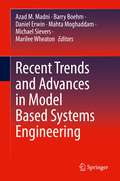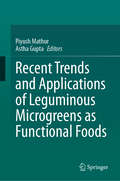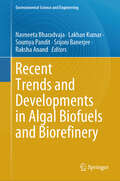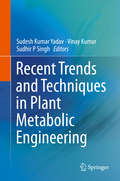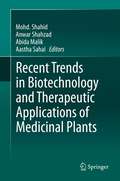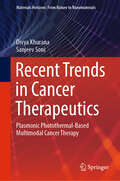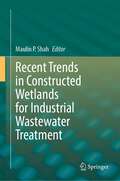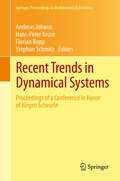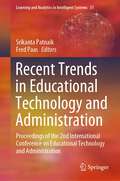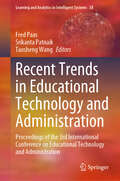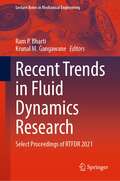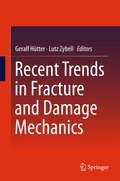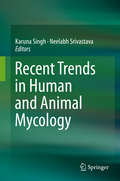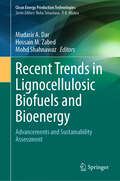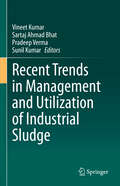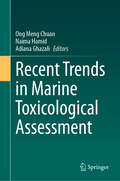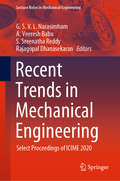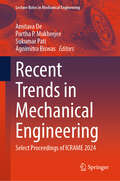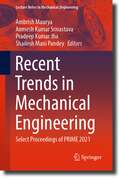- Table View
- List View
Recent Trends and Advances in Model Based Systems Engineering
by Azad M. Madni Barry Boehm Daniel Erwin Mahta Moghaddam Michael Sievers Marilee WheatonThis volume comprises papers from the 18th Conference on Systems Engineering Research (CSER). The theme of this volume, “Recent Trends and Advances in Model-Based Systems Engineering,” reflects the fact that systems engineering is undergoing a transformation motivated by mission and system complexity and enabled by technological advances such as model-based systems engineering, digital engineering, and the convergence of systems engineering with other disciplines. This conference is focused on exploring recent trends and advances in model-based systems engineering (MBSE) and the synergy of MBSE with simulation technology and digital engineering. Contributors have submitted papers on MBSE methods, modeling approaches, integration of digital engineering with MBSE, standards, modeling languages, ontologies and metamodels, and economics analysis of MBSE to respond to the challenges posed by 21st century systems. What distinguishes this volume are the latest advances in MBSE research, the convergence of MBSE with digital engineering, and recent advances in applied research in MBSE, including growing convergence with systems science and decision science. This volume is appropriate as a reference text in graduate engineering courses in Model-Based Systems Engineering.
Recent Trends and Applications of Leguminous Microgreens as Functional Foods
by Piyush Mathur Astha GuptaMicrogreens are the name given to the small, soft, green parts of plants that develop from seedlings and do not bear any real leaves. These microgreens are known to have high nutritional content and are composed of phytoconstituents such as carotenes, phenolics and polysterols which allow for their usage in dietary programs. Legumes provide high nutritional value by enhancing dietary fibre, vitamins and minerals, and are one of the most important sources of plant protein in the human diet. Leguminous microgreens can play a significant role in fulfilling the nutritional requirement of world’s population and will assist in completing the United Nations' global goal of 'zero hunger' (Sustainable Development Goal 2). Recent Trends and Applications of Leguminous Microgreens as Functional Foods provides an in-depth look at the development of leguminous microgreens, such as chickpea, lentils, beans and peas. It covers potential germplasm containing high iron and zinc levels; biomass and nutritive traits that can be used to produce a bio-fortified functional food with appropriate proportions of nutritive components. The book also discusses the increasing interest in production and consumption of microgreens due to their nutritional content, yield rate, rapid production time frame and aroma qualities among other factors. The book also covers management methods for production of biofortified food through conventional, molecular and biotechnological approaches such as hydroponics and aquaponics systems. Additionally, it contains assessments on safety during storage as well information on how to develop value-added products that can supplement food needs/requirements. This book is a valuable tool for anyone looking to gain a comprehensive understanding of this growing sector within agriculture and will provide readers with all they need to know about developing leguminous microgreens for enriched functional foods.
Recent Trends and Developments in Algal Biofuels and Biorefinery (Environmental Science and Engineering)
by Soumya Pandit Navneeta Bharadvaja Lakhan Kumar Srijoni Banerjee Raksha AnandThis book presents technoeconomic challenges, recent trends, and developments toward sustainable algal biofuels and biorefinery. The exponential increase in population and thus the demand for energy, the ever-rising threats to climate change with conventional fossil fuels consumption, fluctuations in fossil fuels price and geopolitical instability have made each and every country of the world to think over its energy independence and security by increasing its own domestic energy production and reducing dependence on scarce fossil fuels. The global need to shift towards a sustainable source of energy has led to the discovery of third and fourth generation biofuels, in which microalgae and their genetically modified strains have been exploited. However, these simple photosynthetic organisms are difficult to select and cultivate for the production of biodiesel. Genetic engineering has opened provisions for the introduction of desired traits to such useful strains. There are also scopes for designing of novel photobioreactors (PBRs) having strain-specific physicochemical parameters, adequate CO2 and nutrient supply, and so on. The role of microalgae in CO2 sequestration from the environment is well known fact. Wastewater treatment plants can be used a raceway pond for the microalgal biomass production, and thus, obtained biomass can be used for biofuels and biochemical production. Mathematical modelling can be used to understand the complex phenomena inside the photobioreactor, which can be a great help to overcome the limitations related to design and scale up of PBRs. Flow hydrodynamics in PBRs has significant effect on the microalgae growth. Computational fluid dynamics (CFD) can be used to study operating and geometry factors in PBRs that influence the flow dynamics, such as the inlet gas flow rate, mixing, mass transfer, reactor geometry. The use of artificial intelligence (AI) particularly artificial neural network model (ANN model), statistical and evolutionary learning-based techniques are some innovative approaches in manipulating and optimizing productivity and costs in algal biofuel production. This book is aimed to bring several aspects of algal biorefinery and microalgal biofuel production, challenges, and future perspective of microalgal biofuel production at a single place.
Recent Trends and Techniques in Plant Metabolic Engineering
by Vinay Kumar Sudesh Kumar Yadav Sudhir P SinghRemarkable research has yielded whole genome data in plants, resulting in the documentation of an ever-increasing number of genes, without establishing their functions. The huge data resources available at the genome, transcriptome, proteome and metabolome levels are of enormous value in the field of functional genomics. This book provides insights into interpreting the sea of data in order to understand basic and practical aspects of plant metabolic engineering. It discusses in detail ways to tap into this enormous pool of data to increase productivity, and offers information that is both interesting and necessary for exploring the manipulation of metabolic pathways. The interdisciplinary approaches presented here also serve as a source of ideas for practical applications.
Recent Trends in Biotechnology and Therapeutic Applications of Medicinal Plants
by Abida Malik Mohd. Shahid Anwar Shahzad Aastha SahaiThe book provides an overview of current trends in biotechnology and medicinal plant sciences. The work includes detailed chapters on various advance biotechnological tools involved in production of phytoactive compounds of medicinal significance. Some recent and novel research studies on therapeutic applications of different medicinal plants from various geographical regions of the world have also been included. These studies report the antimicrobial activity of various natural plant products against various pathogenic microbial strains. Informative chapters on recent emerging applications of plant products such as source for nutraceuticals and vaccines have been integrated to cover latest advances in the field. This book also explores the conservation aspect of medicinal plants. Thus, chapters having comprehensively complied in vitro conservation protocols for various commercially important rare, threatened and endangered medicinal plants were provided in the present book.
Recent Trends in Cancer Biology: Cell Signaling Pathways And Micrornas In Cancer Biology
by Ammad Ahmad Farooqi Sundas FayyazCancer is a multifaceted disease and overwhelmingly increasing experimental evidence has helped us to develop a deeper understanding of the role of signal transduction cascades in cancer development and progression. Tissue microarrays and next generation sequencing technologies have assisted us to gather missing pieces of jigsaw puzzle and we now know that deregulation of spatio-temporally controlled signaling cascades play fundamental role in metastasis and resistance against wide ranging therapeutics.This book offers a balanced overview of the rapidly emerging cutting edge research in molecular oncology and good source of knowledge for established oncologists, basic and medical students and pharmaceutical industry associated R&D departments.
Recent Trends in Cancer Therapeutics: Plasmonic Photothermal-Based Multimodal Cancer Therapy (Materials Horizons: From Nature to Nanomaterials)
by Divya Khurana Sanjeev SoniThis book describes the plasmonic photothermal-assisted multimodal cancer therapeutics in the area of cancer nanotechnology or cancer nanomedicine. This book covers the fundamentals of plasmonic photothermal cancer therapy as well as plasmonic photothermal mediated multimodal cancer therapy. The various steps involved in developing such therapeutic modality, viz. (a) the selection of suitable nanoparticles, (b) synthesis of multifunctional nanocomposite, (c) optimization of the photosensitizer and chemotherapeutic drug loadings, (d) characterization of the synthesized nanocomposite, and (e) therapeutic evaluations through novel tumor-tissue mimicking phantoms and the cancer cell lines are discussed in detail. Apart from the detailed description of therapeutic outcome, this book provides a step-by-step approach to develop a multifunctional nanocomposite for such therapeutics. Overall, this book provides simplified and in-depth information about cancer nanobiotechnology to the researchers and graduate students in subject areas of nanotechnology, biotechnology and pharmaceutics to develop and contribute to such multimodal cancer therapeutics.
Recent Trends in Constructed Wetlands for Industrial Wastewater Treatment
by Maulin P. ShahThis book examines various unique applications and their effectiveness of constructed wetlands for the treatment of complex and heavily polluted wastewater from industrial sources. It also highlights the technological and advanced knowledge in application of constructed wetlands through different microbiological and advanced biochemical technologies. Special attention is paid to suspended solids, organic matter, and nutrient removal. Deep insights are provided for facilities such as those in oil and gas industries, agro-industry, paper and pharmaceutical manufacturing, the textile industry, wineries, breweries, and sludge treatment, among others.Constructed wetlands are low-cost and sustainable systems for wastewater treatment. Traditionally, they have been used for urban and domestic wastewater treatment, but in the last two decades, applications for industrial wastewater treatment have increased due to the advances of the technology and extended research in the field. The advances have also been encouraged by the economic, environmental, and societal advantages over conventional technologies.This book helps academicians and industrialists obtain detailed knowledge about constructed wetlands in the field of wastewater treatment.
Recent Trends in Dynamical Systems
by Florian Rupp Andreas Johann Hans-Peter Kruse Stephan SchmitzThis book presents the proceedings of a conference on dynamical systems held in honor of Jürgen Scheurle in January 2012. Through both original research papers and survey articles leading experts in the field offer overviews of the current state of the theory and its applications to mechanics and physics. In particular, the following aspects of the theory of dynamical systems are covered: - Stability and bifurcation- Geometric mechanics and control theory- Invariant manifolds, attractors and chaos- Fluid mechanics and elasticity- Perturbations and multiscale problems- Hamiltonian dynamics and KAM theoryResearchers and graduate students in dynamical systems and related fields, including engineering, will benefit from the articles presented in this volume.
Recent Trends in Educational Technology and Administration: Proceedings of the 2nd International Conference on Educational Technology and Administration (Learning and Analytics in Intelligent Systems #31)
by Srikanta Patnaik Fred PaasThe management of an educational system is referred to as educational administration. It includes providing leadership for student education, establishing curriculum, carrying out assessments, and managing people and material resources to reach certain goals. It also includes the management of processes within a school system to ensure specific outcomes are achieved. Moreover, educational administration is critical because it allows schools to present opportunities for students to study. As technological advancements drive digital transformation and globalization, teachers may assist students in acquiring the technological skills needed to succeed in future careers. Also, the significance of integrating technology in education administration is to efficiently reach more students and facilitate customized learning through MOOCs, Virtual classrooms, video courses and augmented reality (AR) etc. It not only helps in imparting education but also helps in monitoring the student performance by collecting respective data. This book approaches Educational Technology & Administration while keeping in view these requirements. It not only identifies the gaps in existing educational policies but also suggests new research directions to make the teaching-learning procedure more efficient, accessible and easier. It further recommends development of new innovative policies, practices and reforms encouraging the scope of experimentation while ensuring quality. This book is targeted towards educators working closely in this field, researchers, policy makers and academic administrators working collaboratively towards the enhancement of the education system.
Recent Trends in Educational Technology and Administration: Proceedings of the 3rd International Conference on Educational Technology and Administration (Learning and Analytics in Intelligent Systems #38)
by Srikanta Patnaik Fred Paas Taosheng WangThis book introduces various techniques of educational technology, blending theory with real-world applications, making it an essential tool for a wide range of readers. Different innovative methods covered in this book enhance its usefulness in education administration and management. The content of the book covers chapters both for the beginners and experts, serving as a key reference for educators and administrators. This book serves as a source of fresh ideas for researchers exploring the evolving aspects of educational technology and administration. This book’s wide range of coverage highlights its importance in the education sector, offering new insights and practical solutions that cater to the needs of today's diverse learning settings. By bridging the gap between theory and practice, it facilitates a deeper understanding of the shifting paradigms in education, driven by technological progress and a shift towards more learner-centred models.
Recent Trends in Electrochemical Science and Technology: Proceedings of Papers Presented at NSEST-2020 and ECSIRM-2020 (Springer Proceedings in Materials #15)
by U. Kamachi Mudali S. T. Aruna H. P. Nagaswarupa Dinesh RangappaThis book encompasses select proceedings of NSEST-2020 and ECSIRM-2020. The volume covers advances in major areas of electrochemical science and technology and surface engineering. It covers all aspects of electrochemistry with more emphasis on corrosion. The corrosion topics include self-healing sol-gel based corrosion resistant coatings, nitric acid corrosion of stainless steel, stress corrosion cracking, etc. Few chapters are focused on electrodeposition and new materials for oxygen evolution catalysts, fuel cells and batteries. The chapters on molecularly imprinted polymer sensor for dual analytes, electrochemical sensors for lead ions and dopamine, etc., are of interest. Some papers are related to the green synthesis of nanosized oxides and superhydrophobic coatings. This book will be handy and beneficial to researchers, students, and professionals working in areas related to electrochemistry and surface engineering.
Recent Trends in Fluid Dynamics Research: Select Proceedings of RTFDR 2021 (Lecture Notes in Mechanical Engineering)
by Krunal M. Gangawane Ram P. BhartiThis book presents select proceedings of Conference on Recent Trends in Fluid Dynamics Research (RTFDR-21). It signifies the current research trends in fluid dynamics and convection heat transfer for both laminar and turbulent flow structures. The topics covered include fluid mechanics and applications, microfluidics and nanofluidics, numerical methods for multiphase flows, cavitation, combustion, fluid-particle interactions in turbulence, biological flows, CFD, experimental fluid mechanics, convection heat transfer, numerical heat transfer, fluid power, experimental heat transfer, heat transfer, non-newtonian rheology, and boundary layer theory. The book also discusses various fundamental and application-based research of fluid dynamics, heat transfer, combustion, etc., by theoretical and experimental approaches. The book will be a valuable reference for beginners, researchers, and professionals interested in fluid dynamics research and allied fields.
Recent Trends in Fracture and Damage Mechanics
by Geralf Hütter Lutz ZybellThis book covers a wide range of topics in fracture and damage mechanics. It presents historical perspectives as well as recent innovative developments, presented by peer reviewed contributions from internationally acknowledged authors. The volume deals with the modeling of fracture and damage in smart materials, current industrial applications of fracture mechanics, and it explores advances in fracture testing methods. In addition, readers will discover trends in the field of local approach to fracture and approaches using analytical mechanics. Scholars in the fields of materials science, engineering and computational science will value this volume which is dedicated to Meinhard Kuna on the occasion of his 65th birthday in 2015. This book incorporates the proceedings of an international symposium that was organized to honor Meinhard Kuna's contributions to the field of theoretical and applied fracture and damage mechanics.
Recent Trends in Human and Animal Mycology
by Karuna Singh Neelabh SrivastavaFungal pathogens pose an on-going and serious threat for poikilotherms and homeotherms, and can cause a broad spectrum of diseases ranging from innocuous to life-threatening. In addition, long-term exposure to some mycotoxigenic moulds can lead to mycotoxicoses in human and animals. Given the expanding population of immune compromised hosts, the list of fungal opportunists grows longer every year. Moreover, antifungal resistance, drug-related toxicity and our limited arsenal of antifungals have exacerbated the situation. To address these problems, strategies such as the identification of novel targets, use of the structure-activity relationship in rational drug design, development of new formulations, modification of existing antifungals to combat resistance, and bioavailability enhancement are called for. For the reader’s convenience, this book has been divided into three sections. The first six chapters of Section I provide a timely review of mycoses, from endemic to cosmopolitan and from generalized to specific, while both chapters of Section II focus on risks associated with mycotoxins. In closing, the two chapters of Section III describe potential antifungal leads and drug candidates based on phytochemicals and coumarin scaffold.
Recent Trends in Lignocellulosic Biofuels and Bioenergy: Advancements and Sustainability Assessment (Clean Energy Production Technologies)
by Mohd Shahnawaz Mudasir A. Dar Hossain M. ZabedThis book offers a comprehensive exploration of recent trends in lignocellulosic biofuels, focusing on advancements and sustainability assessments. Edited by leading experts, it provides an in-depth analysis of biofuel production from lignocellulosic biomass, highlighting the latest technological innovations and their environmental impacts. The chapters cover a range of critical topics, including the life cycle assessment of biofuels, the socio-economic implications of bioenergy, and the integration of artificial intelligence in biofuel production. The chapters delve into the environmental, energetic, and economic perspectives of biofuels as sustainable alternatives to fossil fuels. Readers will gain insights into the challenges and solutions for biofuel production, including the role of machine learning and global policy frameworks. This volume is essential for researchers, professionals, and students in the biofuels sector. It offers valuable perspectives on the future of bioenergy, making it a must-read for anyone interested in sustainable energy solutions. Whether you're a policymaker, academic, or industry professional, this book provides the knowledge and tools needed to navigate the evolving landscape of biofuels and bioenergy.
Recent Trends in Management and Utilization of Industrial Sludge
by Sunil Kumar Vineet Kumar Sartaj Ahmad Bhat Pradeep VermaThis book discusses the latest information and advancements on all aspects of sustainable sludge management including treatment, characterization, stabilization, digestion, thickening, dewatering, thermal processing, utilization, valorization production of usable materials, and disposal, with associated pros and cons addressed. It provides an up-to-date resource on industrial sludge generation in various industries, its disposal and treatment by various modern treatment approaches, its physico-chemical and microbiological characterization, as well as legislation, risk assessment, and methodological aspects related to its characterization. Past and recent trends in industrial sludge handling are covered to understand and overcome the environmental risks posed by industrial sludge, with a focus on the brick and agrochemical industries and how to implement sustainable sludge managements practices in these industries. The book is intended for environmental engineers, chemical engineers,soil scientists, and policymakers, and will be of interest to students and researchers of environmental biotechnology, environmental engineering, and chemical engineering.
Recent Trends in Manufacturing and Materials Towards Industry 4.0: Selected Articles from iM3F 2020, Malaysia (Lecture Notes in Mechanical Engineering)
by Muhammed Nafis Osman Zahid Amiril Sahab Abdul Sani Mohamad Rusydi Mohamad Yasin Zulhelmi Ismail Nurul Akmal Che Lah Faiz Mohd TuranThis book presents part of the proceedings of the Manufacturing and Materials track of the iM3F 2020 conference held in Malaysia. This collection of articles deliberates on the key challenges and trends related to manufacturing as well as materials engineering and technology in setting the stage for the world in embracing the fourth industrial revolution. It presents recent findings with regards to manufacturing and materials that are pertinent towards the realizations and ultimately the embodiment of Industry 4.0, with contributions from both industry and academia.
Recent Trends in Marine Toxicological Assessment
by Ong Meng Chuan Naima Hamid Adiana GhazaliMarine pollution is an escalating global concern, with growing awareness of its severe impact on the world’s oceans. Rapid industrialization and intensified human activities have significantly elevated pollution levels, posing a serious threat to marine ecosystems and biodiversity. This book addresses these critical environmental issues by focusing on advanced methodologies for detecting and assessing marine pollutants. It provides a comprehensive overview of the current state of marine toxicology, emphasizing the importance of innovative approaches to protect ocean health and ensure sustainable marine environments. Combining expert contributions worldwide, this book explores the latest developments in marine toxicological assessment. It begins with discussing the sampling methodologies used for analysing legacy and emerging pollutants in aquatic environments, highlighting the distribution and concentration of these pollutants and their impacts on marine life. The book also introduces the adverse outcome pathway (AOP) framework for microscale toxicity testing, which evaluates the effects of pollutants at various biological levels. In addition, it examines in silico techniques and the Toxicology in the 21st Century (Tox21) concept, which employs a comprehensive approach beyond traditional quantitative structure-activity relationship (QSAR) methods. These advanced techniques are essential for predicting ecotoxicological impacts and ensuring chemical safety in marine ecosystems. "Recent Trends in Marine Toxicological Assessment" is designed for a diverse audience, including students, research scholars, and policymakers in environmental science, marine chemistry, marine biology, and biotechnology. It is an invaluable resource for those seeking to enhance their understanding of marine pollution, toxicological assessment, and the latest methods for monitoring and mitigating the impact of pollutants. This book will assist policymakers and environmental managers develop effective strategies to combat marine pollution and protect ocean health. By integrating advanced scientific techniques with practical applications, this book aims to support ongoing efforts to preserve marine ecosystems and promote sustainable practices.
Recent Trends in Materials and Devices: Proceedings of ICRTMD 2019 (Springer Proceedings in Physics #256)
by Vinod Kumar Jain Sunita Rattan Abhishek VermaThis book presents the proceedings of the International Conference on Recent Trends in Materials and Devices (ICRTMD 2019) held in India. It brings together academicians, scientists and industrialists from various fields for the establishment of enduring connections to solve the common global challenges across a number of disciplines. The conference provides a platform to tackle complex problems from a range of perspectives, thereby modeling integrated, solution-focused thinking and partnerships.
Recent Trends in Mechanical Engineering: Select Proceedings of ICIME 2019 (Lecture Notes in Mechanical Engineering)
by G. S. V. L. Narasimham A. Veeresh Babu S. Sreenatha Reddy Rajagopal DhanasekaranThis book comprises select peer-reviewed proceedings from the International Conference on Innovations in Mechanical Engineering (ICIME 2019). The volume covers current research in almost all major areas of mechanical engineering, and is divided into six parts: (i) automobile and thermal engineering, (ii) design and optimization, (iii) production and industrial engineering, (iv) material science and metallurgy, (v) nanoscience and nanotechnology, and (vi) renewable energy sources and CAD/CAM/CFD. The topics provide insights into different aspects of designing, modeling, manufacturing, optimizing, and processing with wide ranging applications. The contents of this book can be of interest to researchers and professionals alike.
Recent Trends in Mechanical Engineering: Select Proceedings of ICIME 2020 (Lecture Notes in Mechanical Engineering)
by G. S. V. L. Narasimham A. Veeresh Babu S. Sreenatha Reddy Rajagopal DhanasekaranThis book consists of peer-reviewed proceedings from the International Conference on Innovations in Mechanical Engineering (ICIME 2020). The contents cover latest research in all major areas of mechanical engineering, and are broadly divided into five parts: (i) thermal engineering, (ii) design and optimization, (iii) production and industrial engineering, (iv) materials science and metallurgy, and (v) multidisciplinary topics. Different aspects of designing, modeling, manufacturing, optimizing, and processing are discussed in the context of emerging applications. Given the range of topics covered, this book can be useful for students, researchers as well as professionals.
Recent Trends in Mechanical Engineering: Select Proceedings of ICRAME 2024 (Lecture Notes in Mechanical Engineering)
by Partha P. Mukherjee Amitava De Sukumar Pati Agnimitra BiswasThis book presents the select proceedings of the 5th International Conference on Recent Advancements in Mechanical Engineering (ICRAME 2024). Various topics covered in this book are thermal engineering, design engineering, manufacturing/production engineering, engineering design, novel materials for thin film solar cells, solar thermal, hydrogen, cryogenic applications, renewable energy, conventional and non-conventional machining, ergonomics, and many more. The book is useful for researchers and professionals working in the various areas of mechanical engineering.
Recent Trends in Mechanical Engineering: Select Proceedings of PRIME 2021 (Lecture Notes in Mechanical Engineering)
by Ambrish Maurya Shailesh Mani Pandey Anmesh Kumar Srivastava Pradeep Kumar JhaThis book contains the select papers presented at the International Conference on Progressive Research in Industrial & Mechanical Engineering (PRIME 2021), held at the National Institute of Technology (NIT) Patna, India. The book discusses various aspects related and relevant to core areas of mechanical engineering including engineering design, production engineering, industrial engineering, automobile engineering, thermal and fluids engineering, mechatronics, control and robotics and other inter-disciplinary emerging topics for potential use in a spectrum of applications. The book will be a valuable reference for students, researchers and professionals interested in mechanical engineering and allied fields.
Recent Trends in Mycological Research: Volume 1: Agricultural and Medical Perspective (Fungal Biology)
by Ajar Nath YadavFungi range from being microscopic, single-celled yeasts to multicellular and heterotrophic in nature. Fungal communities have been found in vast ranges of environmental conditions. They can be associated with plants epiphytically, endophytically, or rhizospherically. Extreme environments represent unique ecosystems that harbor novel biodiversity of fungal communities. Interest in the exploration of fungal diversity has been spurred by the fact that fungi perform numerous functions integral in sustaining the biosphere, ranging from nutrient cycling to environmental detoxification, which involves processes like augmentation, supplementation, and recycling of plant nutrients - a particularly important process in sustainable agriculture. Fungal communities from natural and extreme habitats help promote plant growth, enhance crop yield, and enhance soil fertility via direct or indirect plant growth promoting (PGP) mechanisms of solubilization of phosphorus, potassium, and zinc, production of ammonia, hydrogen cyanides, phytohormones, Fe-chelating compounds, extracellular hydrolytic enzymes, and bioactive secondary metabolites. These PGP fungi could be used as biofertilizers, bioinoculants, and biocontrol agents in place of chemical fertilizers and pesticides in eco-friendly manners for sustainable agriculture and environments. Along with agricultural applications, medically important fungi play a significant role for human health. Fungal communities are useful for sustainable environments as they are used for bioremediation which is the use of microorganisms' metabolism to degrade waste contaminants (sewage, domestic, and industrial effluents) into non-toxic or less toxic materials by natural biological processes. Fungi could be used as mycoremediation for the future of environmental sustainability. Fungi and fungal products have the biochemical and ecological capability to degrade environmental organic chemicals and to decrease the risk associated with metals, semi-metals, and noble metals either by chemical modification or by manipulating chemical bioavailability. The two volumes of Recent Trends in Mycological Research aim to provide an understanding of fungal communities from diverse environmental habitats and their potential applications in agriculture, medical, environments and industry. The books are useful to scientists, researchers, and students involved in microbiology, biotechnology, agriculture, molecular biology, environmental biology and related subjects.
